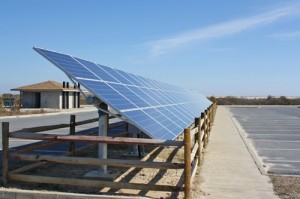
ASSATEAGUE ISLAND — Recent solar installations at Assateague Island are a part of a nationwide campaign to reduce carbon footprints from parks, according to Park Ranger Chuck Zimmerman.
Two solar arrays, generating a combined 29 kilowatts (kw) of energy, have been built at the Assateague Island National Seashore North Beach Parking lot.
The larger array, which measures 175 feet long and 10 feet tall, is capable of producing 22 kw and will be used to provide power to the new ranger station and campground office.
The smaller array, which is 30 feet long and 10 feet tall, can produce 7 kw and will provide power for the adjacent beach hut.
So far, Zimmerman revealed that the new arrays have been able to meet about 50 percent of those building’s power needs, though with the ranger station uncompleted until later this month he predicts that percentage will increase.
“We actually expect better than that,” said Zimmerman.
The combined cost for the installation was roughly $160,000 and was financed by revenue generated by the national park.
“The funds to construct the panels came from the entrance and camping fees, charged at the Seashore,” said Zimmerman.
The panels are the next step in a larger goal initiated by the National Parks Service (NPS) to reduce the carbon footprint of all parks by 25 percent by 2015, said Zimmerman. The 100th Anniversary of NPS will be 2015, according to Zimmerman.
Prior to the arrays being installed, solar panels had already been outfitted onto Assateague Island parking lights and restrooms.
“We’re already utilizing them at all the bathrooms out there,” said Zimmerman.
The next step after the most recent installations will be to attach solar arrays to the mainland to provide power for ranger headquarters. Zimmerman hopes that financing for the project will become available in the near future so Assateague can keep pace with the NPS initiative for emissions reduction.
“We hope to have funding for the design of solar panels for the Visitor Center and headquarters facilities in federal fiscal year 2013, and construction funds in 2014,” he said.
